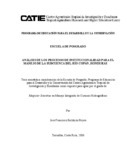| dc.contributor.author | Baldizón Reyes, José F. | |
| dc.date.accessioned | 2014-10-20T04:05:59Z | |
| dc.date.available | 2014-10-20T04:05:59Z | |
| dc.date.issued | 2006 | es_ES |
| dc.identifier | 369744 | es_ES |
| dc.identifier.uri | https://repositorio.catie.ac.cr/handle/11554/4451 | |
| dc.identifier.uri | http://orton.catie.ac.cr/repdoc/A0993e/A0993e.pdf | es_ES |
| dc.description | Tesis (M. Sc) -- CATIE, Turrialba (Costa Rica), 2006 | es_ES |
| dc.description.abstract | El objetivo principal de la investigación fue realizar un análisis participativo de la situación organizacional responsable del manejo de la subcuenca del río Copán y con base en este proponer un modelo de funcionamiento que vinculara el nivel de base, representado por los Comités Ambientales de Microcuenca, el nivel medio, representado por la MANCORSARIC y la Mesa Sectorial de Ambiente y Producción (MONAP) y el nivel de gobierno central, representado por las instituciones nacionales que tienen inferencia en la zona. Los resultados muestran que existe poco empoderamiento de la sociedad civil hacia la MANCORSARIC y hacia los CAM enfatizando en el bajo rendimiento operacional que han tenido estos últimos. Otro aspecto importante es el bajo nivel de cooperación y participación que han tenido las instituciones nacionales con la Mancomunidad, como comité de cuencas. El modelo propuesto incluye recomendaciones para un funcionamiento óptimo tomando en cuenta todos los niveles. The research's main objective was to realize a participative analysis of the current situation of the watershed committee of the Copan river subwatershed and, based on this, to propose a working model that interlaces the base level represented by the Microwatershed Environmental Committees, the middle level represented by MANCORSARIC and the environmental and production stand of work and the central government level represented by national institutions that has inference in the zone. The results show the existence of a lack in the empowerment of the civil society to MANCORSARIC and the Microwatershed Committees emphasizing in the low operational functioning of the last ones. Another important aspects is the absence of cooperation and participation that national institutions has shown as a watershed management committee. The working model proposed includes recommendations for a better function including all the functional levels. | es_ES |
| dc.language.iso | es | es_ES |
| dc.publisher | CATIE, Turrialba (Costa Rica) | es_ES |
| dc.subject | HONDURAS | |
| dc.subject | CUENCAS HIDROGRAFICAS | |
| dc.subject | ORDENACION DE CUENCAS | |
| dc.subject | CONSERVACION DE AGUAS | |
| dc.subject | GESTION | |
| dc.subject | MODELOS | |
| dc.title | Análisis de los procesos de institucionalidad para el manejo de la subcuenca del río Copán, Honduras | es_ES |
| dc.type | Tesis de maestría | es_ES |
| dcterms.rights | acceso abierto | |
| dc.identifier.publication | Turrialba (Costa Rica) | es_ES |


